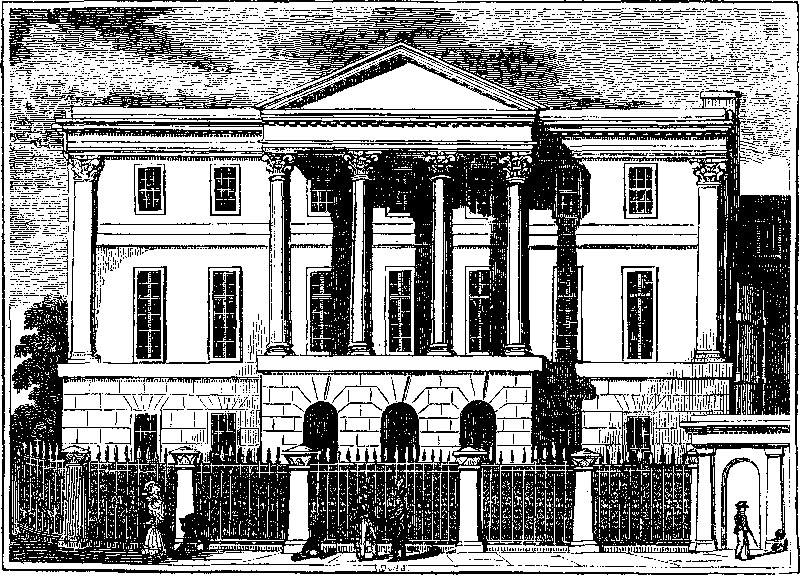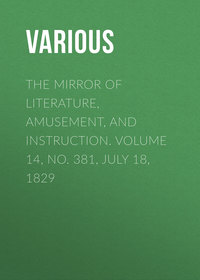Czytaj książkę: «The Mirror of Literature, Amusement, and Instruction. Volume 14, No. 381, July 18, 1829»

THE MANSION OF HIS GRACE THE DUKE OF WELLINGTON
The town mansions of our nobility are generally beneath all architectural criticism; and it has been pertinently observed that "an educated foreigner is quite astonished when shown the residences of our higher nobility and gentry in the British capital. He has heard speak of some great nobleman, with a revenue equal to that of a principality. He feels a curiosity to look at his palace, and he is shown a plain, common, brick house of forty or fifty feet in extent." These observations were made about three years ago, since which period, the spirit of architectural improvement has been fast extending from public buildings to individual mansions. Among the latter, the renovation or encasement of Apsley House, at Hyde Park Corner, with a fine stone front, is entitled to foremost notice.
This splendid improvement is from the designs of Benjamin Wyatt, Esq. and is of the Palladian style. The basement story is rusticated, and the principal front has a handsome pediment supported by four columns of the Corinthian order. A bold cornice extends on all sides, which are decorated at the angles with Corinthian pilasters. The whole has an air of substantial elegance, and is in extremely good taste, if we except the door and window cases, which we are disposed to think rather too small. The Piccadilly front is enclosed with a rich bronzed palisade between leaved pillars, being in continuation of the classical taste of the entrance gates to Hyde Park, and the superb entrance to the Royal Gardens on the opposite side of the road. Throughout the whole, the chaste Grecian honey-suckle is introduced with very pleasing effect.
Besides the new frontage, Apsley House has been considerably enlarged, and a slip of ground from Hyde Park added to the gardens. The ball-room, extending the whole depth of the mansion, is one of the most magnificent salons in the metropolis; and a picture gallery is in progress. Altogether, the improvement is equally honourable to the genius of the architect, and the taste of the illustrious proprietor of the mansion; for no foreigner can gainsay that Apsley House has the befitting splendour of a ducal, nay even of a royal palace.
WATLING STREET
(To the Editor of the Mirror.)
There has been much discussion among antiquaries respecting the etymology of an ancient Roman road, called the Watling Street Way, which commencing from Dover, traces its course to London, St. Alban's, Weedon, over Bensford Bridge,1 High Cross, Atherstone, Wall, Wroxeter, and Chester, from which last place a branch appears to point in nearly a straight direction through St. Asaph to Segontium, or Caer Seiont, Carnarvonshire. Another branch directs its course from Wroxeter to Manchester, York, Lancaster, Kendal, and Cockermouth.
Hoveden thinks it was called the Watling Street from Wathe, or Wathla, a British king. Spelman fancies it was called Werlam Street, from its passing through Verulam. Somner derives the name from the Belgic Wentelen, volvere, versare se, a sinuosis flexibus. Baxter contends that it was made by the original Britons, Weteling, or Oedeling signifying in their language, originarius civis vel ingenuus. Stukeley's opinion, in which he is joined by Whitaker, the Manchester historian, is, that it was the Guetheling road—Sarn Guethelin, or the road of the Irish, the G being pronounced as a W. Dr. Wilkes says, that it is more indented and crooked than other Roman Roads usually are, and supposes that it was formed of Wattles, which was the idea also of Pointer. Mr. Duff is not pleased with the opinion of Camden, that it derives its name from an unknown Vitellianus, but conjectures that its etymology is from the Saxon Wadla, a poor man, a beggar, because such people resorted to this road for the charity of travellers.
Among so many crude and discordant opinions, I shall endeavour to substitute another more consistent with the true etymology of the word. I agree with the historian of Manchester, that the Roman stations were prior to the roads, and that the latter were only the channels of communication to the former. The stations commenced during the conquest of the country, and all of them were completed at the conclusion of it. The roads therefore could not be constructed till the first or second summer after the stations were established. Whoever has attentively observed the line or direction of the Watling Street, must be convinced of the truth of the foregoing observations; and the deviation from a straight line, which in many parts is so apparent, and so evidently made to enable the Romans to pass from one station to another, may be considered conclusive upon this point. I therefore have no hesitation in asserting, that the Watling Street Way is a Roman road, and probably planned and formed by Vespasian, the celebrated Roman general in Britain, who named this road in compliment to the emperor, Vitellius, Vitellii Strata Via, Watling Street Way. Suetonius, in his Life of Vespasian, says, (chapter 4,) "Claudio principe, Narcissi gratiâ, legatus in Germaniam missus est (Vespasianus;) inde in Britanniam translatus, tricies cum hoste conflixit. Duas validissimas gentes, superq viginti oppida, et insulam Vectam Britanniae proximam, in deditionem redegit, partim Auli Plautii legati, partim Claudii ipsius ductu. Quare triumphalia ornamenta, et in spatio brevi, duplex sacerdotium accepit, praeterea consulatum, quem gessit per duos novissimos anni menses." Or, "In the reign of Claudius, by the interest of Narcissus,2 he (Vespasian) was sent lieutenant general of a legion into Germany, from whence being removed into Britain, he engaged the enemy in thirty distinct battles, and subjected to the power of the Romans two very strong nations, and above twenty great towns, and the Isle of Wight, upon the coast of Britain, partly under the command of Aulus Plautius, and partly under that of Claudius himself. In reward for these noble services he received the triumphal ornaments, and in a short time after, two priest's offices, besides the consulship, which he held for the two last months of the year."
The same author, in his Life of Vitellius, seems to strengthen or rather establish the conjecture of its being the Vitellii Strata Via, for he says, (chapter 1,) "indicia, stirpis (Vitelliorum) diu mansisse, Viam Vitelliam ab Janiculo ad mare usque, item coloniam ejusdem nominis." Or, "Some monuments of the family continued a long time, as the Vitellian Way, reaching from the Janiculum to the sea, and likewise a colony of that name." From the abovementioned extracts, it seems not improbable that one of the thirty battles mentioned by Suetonius, might have been fought during the time the Romans were forming this road through the Forest of Arden, which extended from Henley, in Warwickshire, to Market Harborough, in Leicestershire; and that it was called in compliment to Vitellius, the Vitellian Way, afterwards corrupted to the Watling Way.
This road from the Avon, which it passes at Dove Bridge, to the Anker, near Atherstone, forms the boundary between the counties of Leicester and Warwick. In the month of June, 1824, numerous skulls and bones were discovered in a line from the intersection of the road that leads from Rugby to Lutterworth, with the Watling Street to Benones or Bensford Bridge, the distance not being more than half a mile. These bones were lying about two feet below the surface of the ground. Many fragments of shields, spear heads, knives, and a sword,3 placed by the side of a skeleton, and at one end touching a funereal urn,4 and likewise several drinking cups, or small vessels, apparently formed of half-baked clay, with clasps both of silver and brass, were found within the abovementioned distance. On the contrary side of the road were discovered beads, glass, and amber, but neither urns, spear-heads, or fragments of shields; these relics, therefore, probably belonged to the Britons, who fell encountering the Romans, to prevent their forming a road through the Forest of Arden. There can be little doubt of a battle having been here fought, from the bones, urns, and tumuli discovered here and in the adjacent neighbourhood. "In this parish (Church Over,") says Dugdale, "upon the old Roman Way, called Watling Strete, is to be seen a very great tumulus, which is of that magnitude, that it puts travellers beside the usual road," and a Letter from Elias Ashmole to Sir Wm. Dugdale,5 states, "that about a mile from hence (that is from Holywell Abbey, now the site of Caves Inn,) there is a tumulus raised in the very middle of the high way, which methought was worth observing." This tumulus, in an ancient deed, is called the Pilgrim's Low. It was removed in making the turnpike-road from Banbury to Lutterworth, about the year 1770. In the plantations of Abraham Grimes, Esq., within half a mile of the site of the former, is another tumulus of smaller dimensions, adjoining the road which leads from Rugby to Lutterworth.
These were probably raised in honour of some military chiefs who were slain in the battle.
Si quid novisti rectius istis
Candidus imperti: si non, his utere mecum.
